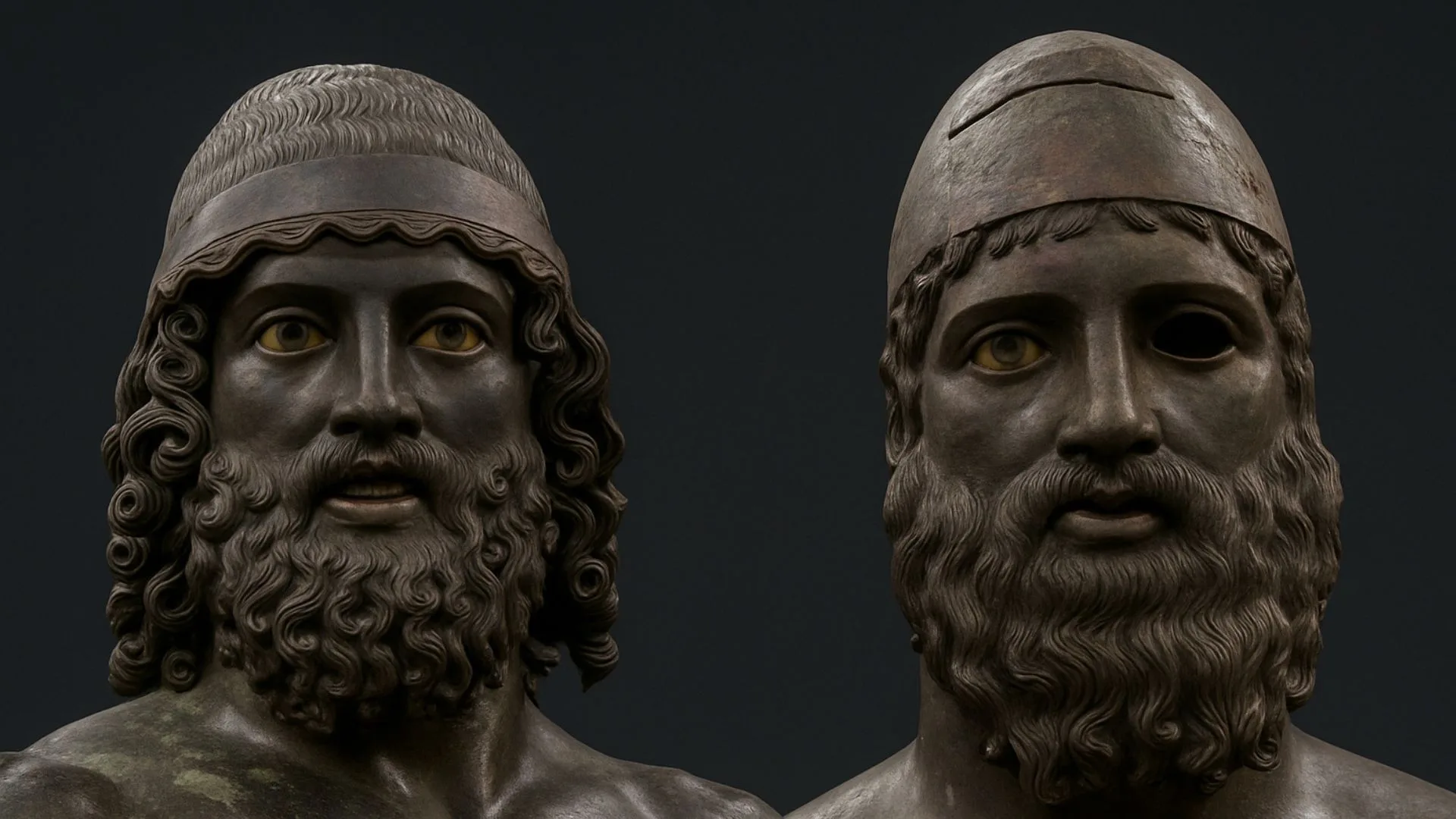By Dr Themistocles Kritikakos (Historian)
In 1972, off the coast near Riace in Calabria, the ‘toe’ of Italy’s boot-shaped peninsula, amateur scuba diver Stefano Mariottini made an extraordinary discovery. While diving 200 metres from the shore at a depth of eight metres, he noticed what appeared to be a human arm protruding from the seabed. Initially fearing it was a dead body, he touched the hand and realised it was a bronze sculpture. After notifying the local authorities, two days later, a team from Calabria’s Superintendency of Antiquities unearthed two Greek bronze statues of warriors, believed to have been buried for over 2,000 years.
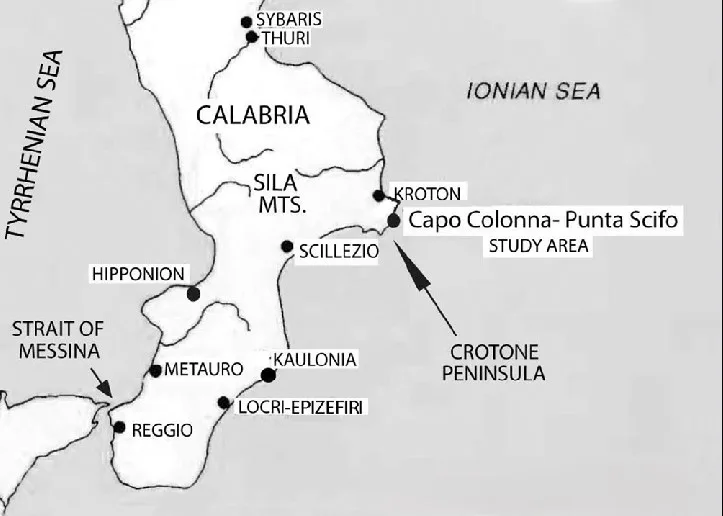
These statues, now known as the Riace Bronzes (Bronzi di Riace), are believed to date between 460 and 430 BCE during the height of classical Greek sculpture. The sculptures reflect the technical mastery and aesthetic ideals of the Classical period, including the life-like representation of strength, beauty, and civic virtue. The bronzes’ origins are still debated, but they may have been destined for or transported from one of Magna Graecia’s prominent Greek cities, possibly related to the regional conflicts or political tensions of the period.
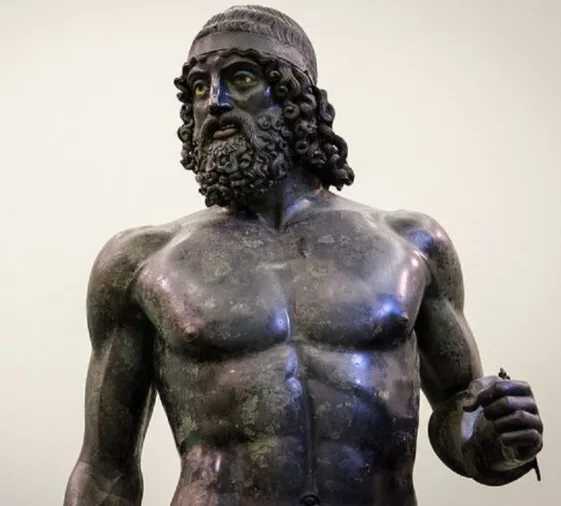
Calabria’s history, like other regions in southern Italy, reflects layers of indigenous, Greek, and foreign influence. Before Greek colonisation, it was inhabited by Italic and pre-Italic peoples such as the Oenotrians and later the Bruttians. From the eighth century BCE, Greek settlers founded flourishing cities along Calabria’s coastline as overpopulated city-states sought new lands and trade opportunities. Around 730 BCE, Euboeans from Chalcis established Rhegion (modern Reggio Calabria), strategically located at the peninsula’s tip. Around 720 BCE, Greeks from Achaea colonised Sybaris. Achaeans then founded Kroton (modern Crotone) around 710 BCE, and settlers from Locris (central Greece) established Epizephyrian Locris (modern Locri) by the late seventh century BCE. Attracted by the region’s fertile land and natural harbours, these communities not only secured political influence but also developed into important centres of Hellenic culture and thought.
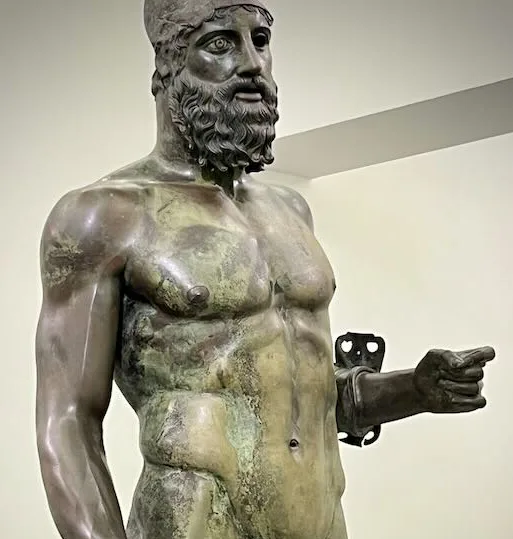
Centres of intellectual innovation
Around 530 BCE, Pythagoras migrated from Samos to Kroton at the age of 40, fleeing the tyrannical rule of Polycrates. Drawn by the opportunity for influence, he established a school in Kroton that combined mathematical study with ethical and spiritual teachings. He formalised the geometric theorem that now bears his name, discovered the mathematical basis of musical harmony, and introduced philosophical ideas such as the immortality and transmigration of the soul. His focus on logic and abstract reasoning influenced later thinkers like Plato and contributed to viewing the universe as governed by discoverable laws.
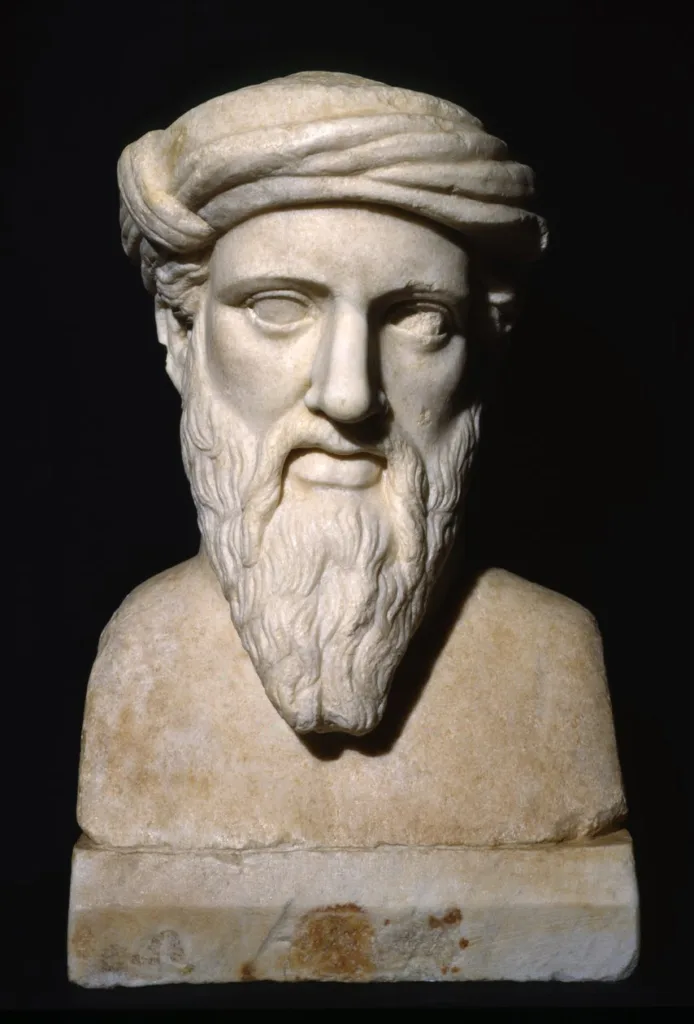
Kroton also became a centre of early medical thought through figures such as Alcmaeon of Kroton, a fifth century BCE philosopher and scientist. His claim that the brain, not the heart, was the centre of thought reflected an empirical approach that shaped future scientific and philosophical inquiry. His emphasis on observation, particularly concerning the physical workings of the mind, influenced later developments in medicine.
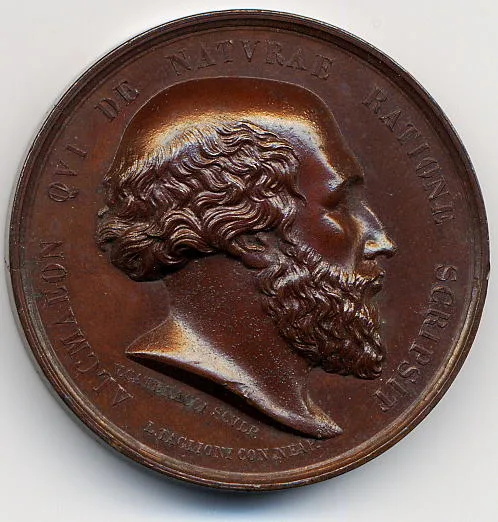
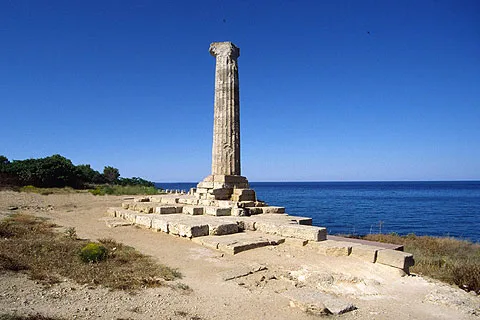
In Epizephyrian Locris, the lawgiver Zaleucus introduced one of the earliest known written legal codes around the seventh century BCE. By publicly displaying laws and moving away from oral traditions and arbitrary rule, he established principles of transparency and fairness. According to legend, Zaleucus’ commitment to justice was such that when his own son broke the law, he shared in the punishment by removing one of his own eyes, symbolising the ideal that the law should apply equally to all citizens regardless of status.
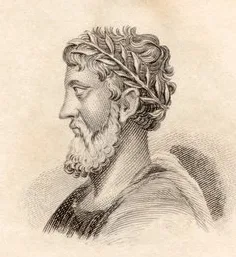
The poetry of Nossis of Locri offers a valuable perspective on third-century BCE Greek life, articulated from a distinctly female viewpoint. Although only twelve of her epigrams survive, they reveal a self-assured poet who explores themes of love, beauty, and religious devotion, while notably aligning herself with Sappho’s literary legacy. Through references to the Hellenistic playwright Rhinthon, her poetry can be situated in its historical context, offering a rare surviving perspective on the literary voice and lived experiences of women in the ancient Greek world.
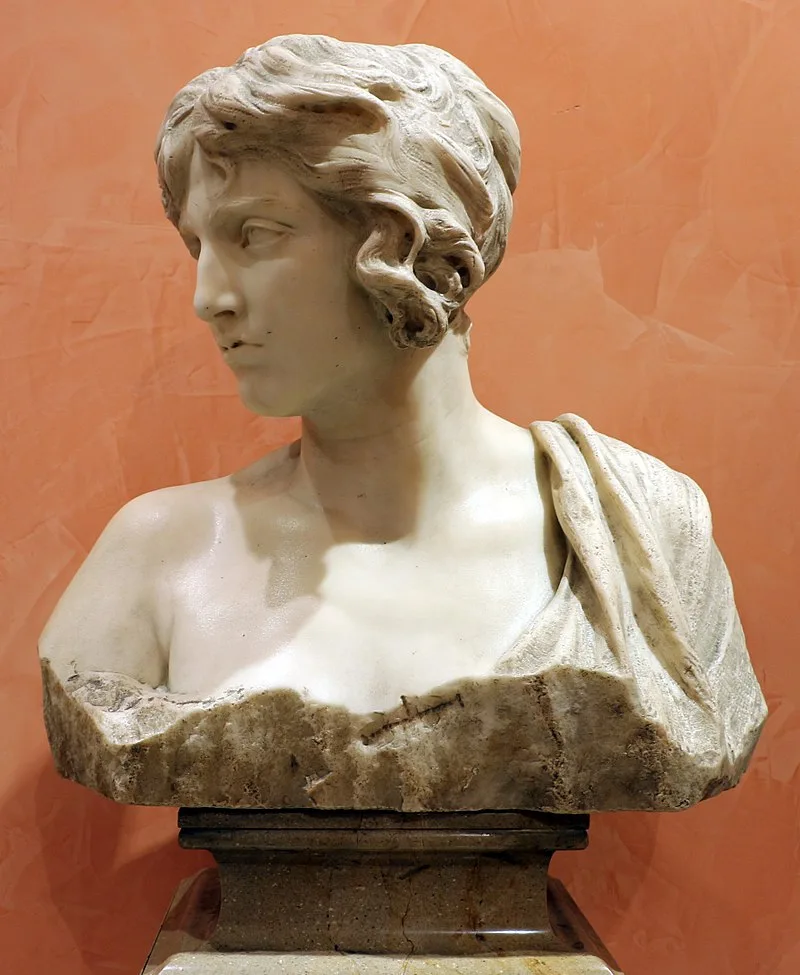
Political Conflict and Regional Power
In Calabria, shifting alliances and rivalries marked the Hellenic communities as they competed for economic and territorial dominance. A notable conflict occurred between Kroton and the wealthy city of Sybaris in the sixth century BCE. Ancient sources, including Herodotus, Strabo, Diodorus Siculus, and Athenaeus, characterise the rivalry as a clash of opposing values. Sybaris was renowned for its luxury and indulgence, while Kroton upheld ideals of discipline and athletic excellence.
Economic competition over trade routes and territory further heightened tensions. Around 510 BCE, Kroton’s forces, reportedly led by the legendary Olympic wrestler Milo of Kroton, destroyed Sybaris. Some ancient sources claim that Kroton diverted a river to flood the city. This victory cemented Kroton’s status as the dominant regional power.
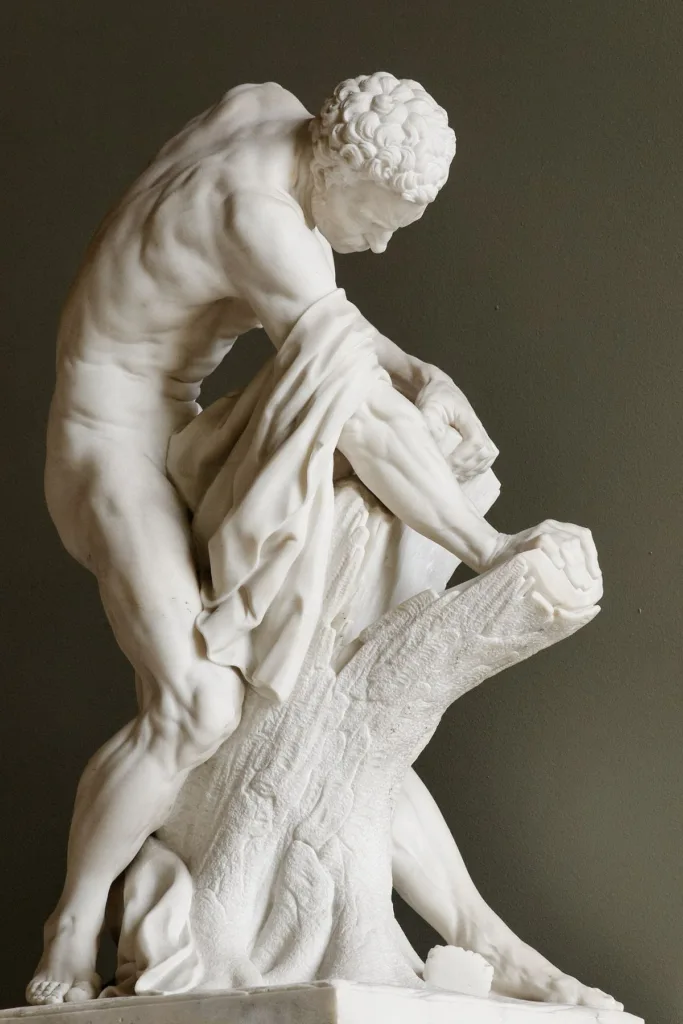
About a century later, during the Peloponnesian War (431–404 BCE), Rhegion (modern Reggio Calabria), not far from Riace, allied with Athens during the ill-fated Sicilian Expedition (415–413 BCE). According to Thucydides, it was in Rhegion that the Athenians established their camp before launching their attack on Syracuse, which was allied with Sparta and Corinth.
Survival through conquest
The Roman conquest in the third century BCE introduced new administrative structures, yet elements of Calabria’s Greek character endured. Greek continues to be spoken in various areas, while local customs, urban planning, and traditional practices continued alongside Roman governance. Between the sixth and eleventh centuries CE, Byzantine rule played a role in sustaining this heritage. During this period, Greek was widely used in administration, the religious practices of the Orthodox Christian Church, monastic life, and education. Following Norman rule, the region experienced centuries of changing control under various European dynasties, primarily Spanish and French, until becoming part of unified Italy in 1861.
Heritage in motion
In the remote southern reaches of Calabria, the legacy of Hellenic civilisation endures in the area known as Bovesia, or Grecia Calabra, where the Greko dialect, shaped by ancient Doric Greek, Byzantine Greek and modern Italian, is still spoken by a small number of elderly residents. Villages such as Bova Superiore, Roghudi, Gallicianò, Condofuri, Roccaforte del Greco, and Bova Marina form the heart of this linguistic and cultural community. With only 200 to 300 active speakers remaining, the future of Greko is uncertain, particularly as younger generations migrate to urban centres for employment. Since the unification of Italy in 1861, the predominant use of standard Italian in education and media has contributed to the decline of regional languages and dialects such as Greko.
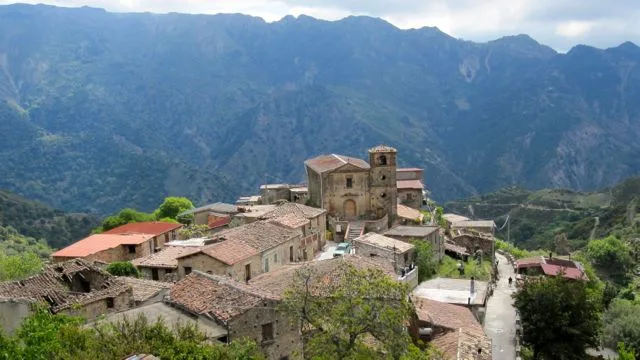
Linguists classify Greko as critically endangered. Yet recent preservation efforts offer hope. Calabria has formally recognised its Greek minority, establishing bilingual education programs and the Istituto Regionale Superiore di Studi Ellenofoni in Bova Marina. The Museo della Lingua Greco-Calabra “Gerhard Rohlfs” documents the language’s history and development. Cultural festivals and educational initiatives now aim to revitalise this linguistic heritage among younger generations.
At the same time, archaeological excavations at Locri Epizefiri in Calabria have confirmed its status as one of southern Italy’s most important ancient cities. Temples dedicated to deities such as Persephone, Athena, and Zeus, along with terracotta plaques, marble statues, and bronze artefacts, highlight the city’s rich religious and artistic life. The discovery of city walls, private buildings, and a large Greek-Roman theatre further illustrates Locri’s significance within Magna Graecia.
Today, the legacy of Magna Graecia is embraced as part of both Greek and Italian heritage. The Riace Bronzes remain the most compelling symbol of this classical past. Displayed at the National Archaeological Museum in Reggio Calabria, these well-preserved sculptures provide a rare glimpse into ancient Greek civilisation in Magna Graecia.
From Pythagoras’ teachings to today’s Greko communities, Hellenic civilisation has persisted and evolved through migration and adaptation. Recovered from the depths of the Mediterranean, the bronze warriors stand as enduring testaments to Hellenic civilisation and its intellectual and cultural legacy, which shaped the Western world and continues to resonate today.
The Magna Graecia series will resume during the week of 21 July.
Next in the series: Part 4 explores Sicily, with a focus on Siracusa, the birthplace of Archimedes. Siracusa played a pivotal role in the Peloponnesian War and was one of antiquity’s most important Hellenic centres.
Links to the series:
Magna Graecia – Part 1: Hellenism beyond the homeland
Magna Graecia – Part 2: The Greek foundations of a new city
*Dr Themistocles Kritikakos is a Greek-Australian historian, philosopher and writer. He holds a PhD in History from the University of Melbourne. His forthcoming book explores intergenerational memories of violence in the late Ottoman Empire, identity, and communal efforts toward genocide recognition, focusing on the Armenian, Greek, and Assyrian communities in Australia.
